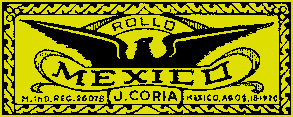| You Are Not Logged In | Login/Get New Account |
|
Please Log In. Accounts are free!
Logged In users are granted additional features including a more current version of the Archives and a simplified process for submitting articles. |
|
MMD
 MMMedia
MMMedia
 RMX
RMX
|
|
recollections by Ed Gaida
Articulo 123, the street where Rollos Mexico was located, may have seemed like a back alley to visitors, but it was one of the main streets running north and south to the center of the Mexico City. Most streets in "El Centro" (City Center) are narrow, only wide enough for two vehicles. Add a streetcar in the middle and one waited or drove around it unless it was stopped! The streetcar line that I rode to my house passed Rollos Mexico everyday on my way home from college (1958!). I first met Sr. Lodoza in 1959 and I visited him every time I went to Mexico after that. No one went to his shop for new rolls. What all of us went there for in those days were the unbelievable number of reproducing rolls he had -- hundreds of all kinds, many of them going back to before he took over the firm: Ampico, Duo-Art and Welte-Mignon, and different kinds of rolls for the European Welte orchestrions. He did most of the arranging on a special perforator in the front room behind the counter. It was an unusual master roll cutting machine (it wasn't a Leabarjan) which had levers that you clicked down for the notes you wanted, not unlike what QRS uses. One revolution of the wheel at the side was one step on the roll -- punch, skip, punch, skip, etc. He was a fine musician, and his arrangements have a distinct quality to them. My all-time favorite is "Tico Tico", and he signed the roll leader for me. Stamped in the box bottom of all the rolls from Lodoza was this legend, and I am going to type the whole thing in Spanish and then translate: No tire sus rolls usados o rotos.
Literal translation: Do not throw away your worn out used rolls,
His full name was Fernando Diaz Lodoza. He was a poor man, somewhat taciturn, and he wore "coke bottle" eye glasses. He perforated the rolls on varying degrees of paper, some almost resembling mulberry paper that still had what looked like pieces of wood bark in it. None of his new production rolls were ever put on spools until he sold them. They were kept in little bins along the walls -- cubicles made of scrap wood and thin wire which he had made himself. You picked out what you wanted to hear, then you had to wait while he put it on a spool. Then you played it sitting at a wheezing pumper kept in the front room for that purpose. After you were through playing the roll, he unwound it from the spool and put it back on the shelves. I asked him why and he said because the flanges and cores were very expensive. It took me five years of talking and begging before he let me see the perforator. "Es un secreto", he would say, and he would allow no one in the back room. But in later years he wanted to sell everything .. He had lost his lease and finally, after all those years, he took me into the back room and showed me everything, He showed me his Acme perforator, and he made a roll for me while I watched. If you look at the completed "Rollo Mexico" rolls there are no continuous slots perforated. And I am almost sure that the Acme was a one-to-one perforator. By the way, it was driven with flat belting running off a line shaft in the ceiling, just as it had been installed many years before. None of his masters was a complete roll. He arranged in sections, and marked the master in red pencil. The introduction was cut, then the verse, then the refrain, then a "bridge". Then he stopped the perforator and backed up the master roll to punch the second verse, which of course was the same as the first verse. After two verses or more, he moved the master to the ending that he had arranged. This accounts for some of the jerky movements to his finished product. The paper he used (the only thing he could find in Mexico) also tended to slip on the outfeed tractor. All of this was marked on the master in red crayon, in Spanish, as to what order it was all to go in. In that back room was even the machine for stenciling the words on the rolls, and the machine that cut the stencil. He offered me the business for a song, but I was too busy making money repairing player pianos, and anyway, getting things out of Mexico was not as easy as it is now. What his relationship with J. Coria was, I could not say. I understand that the Acme perforator was sold to John Malone (Play-Rite, Turlock, CA), and then it went to Don Rand in Thomaston, Maine. A picture of it was published in the AMICA Bulletin in 1995. Ed Gaida
[ See also "Profundidad", Rollo Mexico 1329 ]
28 October 2002 |
|
|
|
|
|
|
|
|
|
CONTACT FORM: Click HERE to write to the editor, or to post a message about Mechanical Musical Instruments to the MMD Unless otherwise noted, all opinions are those of the individual authors and may not represent those of the editors. Compilation copyright 1995-2026 by Jody Kravitz. Please read our Republication Policy before copying information from or creating links to this web site. Click HERE to contact the webmaster regarding problems with the website. |
|
|
||||||
|
